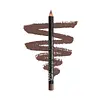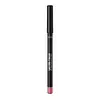What's inside
What's inside
 Key Ingredients
Key Ingredients

 Benefits
Benefits

 Concerns
Concerns

 Ingredients Side-by-side
Ingredients Side-by-side

Phenyl Trimethicone
Skin ConditioningMicrocrystalline Wax
Emulsion StabilisingHydrogenated Cottonseed Oil
EmollientHydrogenated Coco-Glycerides
EmollientCocoglycerides
EmollientSynthetic Beeswax
Emulsion StabilisingCopernicia Cerifera Wax
C10-18 Triglycerides
EmollientOzokerite
Emulsion StabilisingPolyethylene
AbrasiveAlumina
AbrasivePolybutene
Hydrogenated Vegetable Oil
EmollientParaffin
PerfumingHydrogenated Microcrystalline Wax
Emulsion StabilisingStearic Acid
CleansingPalmitic Acid
EmollientCaprylyl Glycol
EmollientHydrogenated Polyisobutene
EmollientTalc
AbrasiveBenzoic Acid
MaskingTin Oxide
AbrasivePentaerythrityl Tetra-Di-T-Butyl Hydroxyhydrocinnamate
AntioxidantSodium Chlorite
Dolomite
AbrasiveCI 77120
Cosmetic ColorantCI 77713
Cosmetic ColorantPhenoxyethanol
PreservativeMica
Cosmetic ColorantCI 77891
Cosmetic ColorantIron Oxides
CI 19140
Cosmetic ColorantCI 15985
Cosmetic ColorantCI 15850
Cosmetic ColorantCI 42090
Cosmetic ColorantCI 45380
Cosmetic ColorantCI 45410
Cosmetic ColorantCI 73360
Cosmetic ColorantCI 17200
Cosmetic ColorantCI 12085
Cosmetic ColorantCI 16035
Cosmetic ColorantCI 77742
Cosmetic ColorantPhenyl Trimethicone, Microcrystalline Wax, Hydrogenated Cottonseed Oil, Hydrogenated Coco-Glycerides, Cocoglycerides, Synthetic Beeswax, Copernicia Cerifera Wax, C10-18 Triglycerides, Ozokerite, Polyethylene, Alumina, Polybutene, Hydrogenated Vegetable Oil, Paraffin, Hydrogenated Microcrystalline Wax, Stearic Acid, Palmitic Acid, Caprylyl Glycol, Hydrogenated Polyisobutene, Talc, Benzoic Acid, Tin Oxide, Pentaerythrityl Tetra-Di-T-Butyl Hydroxyhydrocinnamate, Sodium Chlorite, Dolomite, CI 77120, CI 77713, Phenoxyethanol, Mica, CI 77891, Iron Oxides, CI 19140, CI 15985, CI 15850, CI 42090, CI 45380, CI 45410, CI 73360, CI 17200, CI 12085, CI 16035, CI 77742
Hydrogenated Palm Oil
EmollientHydrogenated Coco-Glycerides
EmollientEthylhexyl Stearate
EmollientHydroxylated Lanolin
EmollientMicrocrystalline Wax
Emulsion StabilisingMethylparaben
PreservativePropylparaben
PreservativeTocopherol
AntioxidantAscorbyl Palmitate
AntioxidantLecithin
EmollientGlyceryl Stearate
EmollientGlyceryl Oleate
EmollientCitric Acid
BufferingMica
Cosmetic ColorantCI 15850
Cosmetic ColorantIron Oxides
CI 77891
Cosmetic ColorantCI 19140
Cosmetic ColorantCI 45380
Cosmetic ColorantCI 75470
Cosmetic ColorantCI 42090
Cosmetic ColorantHydrogenated Palm Oil, Hydrogenated Coco-Glycerides, Ethylhexyl Stearate, Hydroxylated Lanolin, Microcrystalline Wax, Methylparaben, Propylparaben, Tocopherol, Ascorbyl Palmitate, Lecithin, Glyceryl Stearate, Glyceryl Oleate, Citric Acid, Mica, CI 15850, Iron Oxides, CI 77891, CI 19140, CI 45380, CI 75470, CI 42090
 Reviews
Reviews

Ingredients Explained
These ingredients are found in both products.
Ingredients higher up in an ingredient list are typically present in a larger amount.
Ci 15850 is the pigment color red. It is an azo dye and created synthetically.
Azo dyes need to be thoroughly purified before use. This allows them to be more stable and longer-lasting.
This ingredient is common in foundations, lipsticks, and blushes. This color is described as brown/orangey red.
It has many secondary names such as Red 6 and Red 7. According to a manufacturer, Red 6 usually contains aluminum.
Learn more about CI 15850CI 19140 is also known as Tartrazine. Tartrazine is a synthetic dye used in cosmetics, foods, and medicine to add a yellow color.
Tartrazine is created from petroleum and is water-soluble.
Some people may experience allergies from this dye, especially asthmatics and those with an aspirin intolerance.
Learn more about CI 19140Ci 42090 is a synthetic dye created from petroleum. It is used to give a bright blue color to cosmetics, medicine, and food.
Ci 45380 is a synthetic dye that comes from coal or tar sources. Due to this, it is often used in small quantities.
A common name for this dye is Red 22. Red 22 imparts a warm reddish color.
Similar to Red 27, this dye changes color based on pH and moisture levels.
This dye is colorless when dry but turns pink between pH levels 0.0 to ~3.0.
Learn more about CI 45380Ci 77891 is a white pigment from Titanium dioxide. It is naturally found in minerals such as rutile and ilmenite.
It's main function is to add a white color to cosmetics. It can also be mixed with other colors to create different shades.
Ci 77891 is commonly found in sunscreens due to its ability to block UV rays.
Learn more about CI 77891Hydrogenated Coco-Glycerides isn't fungal acne safe.
Mica is a naturally occurring mineral used to add shimmer and color in cosmetics. It can also help improve the texture of a product or give it an opaque, white/silver color.
Serecite is the name for very fine but ragged grains of mica.
This ingredient is often coated with metal oxides like titanium dioxide. Trace amounts of heavy metals may be found in mica, but these metals are not harmful in our personal products.
Mica has been used since prehistoric times throughout the world. Ancient Egyptian, Indian, Greek, Roman, Aztec, and Chinese civilizations have used mica.
Learn more about MicaMicrocrystalline Wax is created by de-oiling petroleum. It is highly refined and purified before being added to cosmetics.
Microcrystalline Wax is used to enhance the texture and create even consistency. It helps stabilize a product by preventing ingredients from separating.
This ingredient is a combination of red, black, and yellow iron oxide pigments. This combination of colors is usually found in foundation, because it results in a "skin" color.